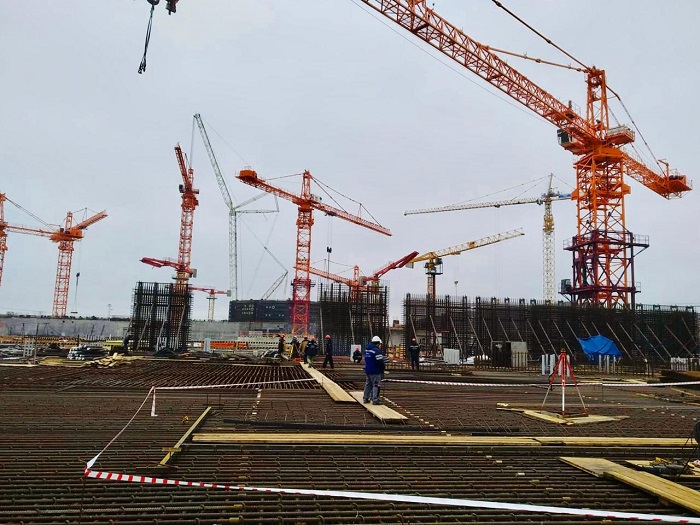On April 15, 2019 the team placed the first cubic meter of concrete at the construction site for the replacing Kursk NPP-2 (an affiliate of the Rosenergoatom Joint-Stock Company, a part of the Electric Power Division of ROSATOM), which marked the start of concreting the 2nd power block’s reactor building foundation. This means that the major construction activities related to building another most powerful and modern power blocks in Russia with 3+ generation VVER-TOI reactors have started almost two weeks ahead of schedule.

The 3+ generation 1st and 2nd power blocks of the Kursk NPP-2 are the pilot ones that are being constructed following the VVER-TOI project (typical optimized information-based water-water energy reactor). This new project was introduced by Russian designers (Atomstroyexport, an engineering division of the Rosatom State Corporation) based on the VVER-1200 NPP technical solutions.
The concreting of the ‘nuclear island’ foundation was preceded by a large amount of preparation activities. An artificial substructure was formed under the 2nd power block’s reactor building to achieve the soil condition set forth in the design and regulatory technical documentation.
At the moment, over 2600 people work at the Kursk NPP-2 site. Following the plan, they perform assignments at 17 facilities of the 1st and the 2nd power blocks and are involved into creating sand and sand-and-gravel bases for buildings and constructions.
The Kursk NPP-2 power blocks are erected using the industrial large-block construction methods, when the reinforced concrete blocks produced in bulk are fully ready for the installation with the site pre-assembly. This method reduced the time and efforts required to do the job.
All in all, over 16.7 thousand cubic meters of self-consolidating concrete mix will be placed into the foundation of the 2nd power block’s reactor building. This amount of material is similar to the one required to erect 15 five-storey buildings with three entrances each.
The concreting will go on 24/7, and the quality control will be executed all the time. These activities are scheduled to be finished this summer.
In general, this year the construction team is to finalize concreting at 27 construction facilities with the total amount of concrete being 167 thousand cubic meters. The most immediate plan is to complete the concreting of the tendon gallery flooring for the containment pre-tensioning system of the 1st power block’s reactor building.
The 3+ generation nuclear power blocks boast advanced technical and economic properties. Compared to the former-generation power blocks (VVER-1000), their capacity has increased by 25%, up to 1255 megawatt, the life span of the core equipment has doubled. Thanks to the high automation coverage, the number of required staff has been reduced by 30-40%.
Compared to other 3+ generation power blocks (the Novovoronezh NPP-2 1st and 2nd ones and the Leningrad NPP-2 1st and 2nd ones), the VVER-TOI project pre-supposes that the construction costs, time lines and the operational expenses are cut significantly.
The new Kursk NPP-2 power blocks comply with the most up-to-date IAEA safety standards. An array of the top-notch safety systems have been implemented, such as a ‘melt trap’ at the reactor core and an afterheat removal passive system designed to cool down the reactor core using natural air circulation when the energy supply is off.
Additionally, compared to the previously constructed 3+ generation power blocks, the VVER-TOI project takes advantage of extra safety measures. For example, the power block is designed to survive an 8-9 points earthquake vs. a 7-point earthquake stipulated for VVER-1200 NPPs. The Kursk NPP-2 power blocks also possess improved maneuverability, which is important for rational capacity usage. They can be safely operated on any site from the tropics up to the northern regions.
For reference:
The Kursk NPP is among the Top 4 nuclear power plants in Russia with the same capacity and is one of the most important hubs in the Unified Energy System. The ‘Center’ energy system covering 19 regions of the Central Federal District of Russia is its main consumer. The Kursk NPP accounts for over 50% of all electric power stations’ capacity in the Central Black Earth Region. It supplies the majority of manufacturing companies in the Kursk region with electric power.
The Kursk NPP-2 is supposed to replace the capabilities of the operating Kursk NPP power blocks that were launched operational in 1976-1985. The Kursk NPP-2 1st and 2nd 3+ generation power blocks are the pilot projects constructed following the VVER-TOI project (typical optimized information-based water-water energy reactor). Their joint electric power capacity is 2510 megawatt, which is 510 megawatt higher than the one of the currently operated Kursk NPP power blocks. The capacity of each Kursk NPP-2 power block exceeds the capacity of any newly introduced power block in Russia.
The developer and the technical customer – the Rosenergoatom Joint-Stock Company. The general contractor and the general designer – the Atomstroyexport Group, an engineering division of the ROSATOM.